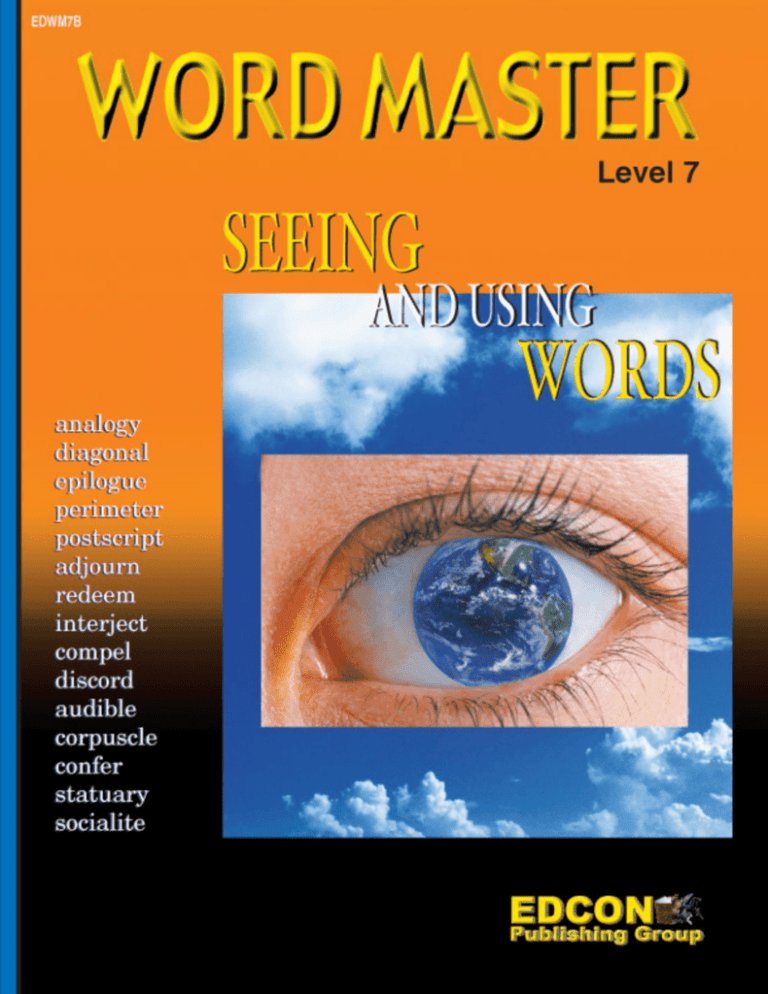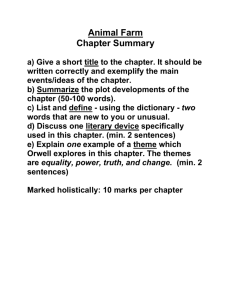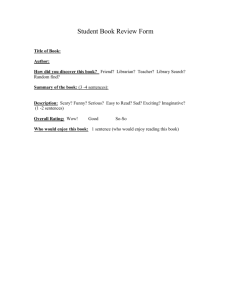
Word Master
Seeing and Using Words
LEVEL 7
Lessons 1- 30
Series Designer
Philip J. Solimene
Editors
Janice Colby Solimene
Laura Solimene
Consultant
Douglas P. Barnard, Ed.D
Author
David L. Bacon
EDCON PUBLISHING GROUP
www.edconpublishing.com
Copyright © 2005
EDCON Publishing
AV Concepts Corp.
30 Montauk Blvd. Oakdale NY 11769
info@edconpublishing.com
www.edconpublishing.com
1-888-553-3266
Fax 1-888-518-1564
Copyright © 2005 by EDCON Publishing and AV Concept Corp. All rights reserved. No part of this book may be
reproduced in any form or by any means, electronic or mechanical, including photocopying, recording, or by any
information storage retrieval system without written permission of the publisher, with the following exception.
Student activity pages are intended for reproduction. EDCON Publishing grants to individual purchasers of this
book the right to make sufficient copies of reproducible pages for use by all students of a single teacher. This permission is limited to an individual teacher, and does not apply to entire schools or school systems.
Printed in U.S.A.
ISBN# 0-931334-39-X
CONTENTS
Introduction
v
The Way to Use This Book
v
SEQUENCE
7- 1
7- 2
7- 3
7- 4
7- 5
7- 6
7- 7
7- 8
7- 9
7-10
7-11
7-12
7-13
7-14
7-15
. . . . . . . . . . . . . .1
. . . . . . . . . . . . . .5
. . . . . . . . . . . . . .9
. . . . . . . . . . . . .13
. . . . . . . . . . . . .17
. . . . . . . . . . . . .21
. . . . . . . . . . . . .25
. . . . . . . . . . . . .29
. . . . . . . . . . . . .33
. . . . . . . . . . . . .37
. . . . . . . . . . . . .41
. . . . . . . . . . . . .45
. . . . . . . . . . . . .49
. . . . . . . . . . . . .53
. . . . . . . . . . . . .57
7-16
7-17
7-18
7-19
7-20
7-21
7-22
7-23
7-24
7-25
7-26
7-27
7-28
7-29
7-30
. . . . . . . . . . . . .61
. . . . . . . . . . . . .65
. . . . . . . . . . . . .69
. . . . . . . . . . . . .73
. . . . . . . . . . . . .77
. . . . . . . . . . . . .81
. . . . . . . . . . . . .85
. . . . . . . . . . . . .89
. . . . . . . . . . . . .93
. . . . . . . . . . . . .97
. . . . . . . . . . . .101
. . . . . . . . . . . .105
. . . . . . . . . . . .109
. . . . . . . . . . . .113
. . . . . . . . . . . .117
EXERCISE G . . . . . . . . . . . . . . . . . . . . . . . . . . . . . . . . . . . . . . . . . . . . . . . . . . . . . . . . . .121-135
ANSWER KEY . . . . . . . . . . . . . . . . . . . . . . . . . . . . . . . . . . . . . . . . . . . . . . . . . . . . . . . . .137-146
PROGRESS CHART . . . . . . . . . . . . . . . . . . . . . . . . . . . . . . . . . . . . . . . . . . . . . . . . . . .147-151
Pronunciation Key . . . . . . . . . . . . . . . . . . . . . . . . . . . . . . . . . . . . . . . . . . .Inside Back Cover
iii
INTRODUCTION
What do you do when you see a word you do not know? Do you use a dictionary to learn
its meaning, do you look at the parts of the word to find a “root” word, or do you try to understand the word’s meaning from its context?
New words can be learned in different ways. One good way to understand the meaning
of a word is to understand what it means in the sentence or paragraph where it is used. To do
this, you must understand the meaning of the sentence or paragraph you are reading.
However, understanding a word in context will not always teach you all you should
know about the word. A dictionary will be needed for you to learn how to pronounce the word
and to learn the word’s meaning or meanings.
This book will help you to:
1. Learn the use of context clues
2. Learn the use of a dictionary
3. Learn the different forms of words
THE WAY TO USE THIS BOOK
Look at the CONTENTS page (page iii). The large black type will show you the four
main parts of the book: SEQUENCE 7-1 through SEQUENCE 7-30, EXERCISE G, ANSWER
KEY, and PROGRESS CHART.
Then, turn to SEQUENCE 7-1. Look at the four pages that make up SEQUENCE 7-1.
Every sequence in the book is similar. Every sequence has six sections that follow one another:
A
B
C
D
E
F
Writing the Words
Using Context Clues
Checking the Meaning
Completing the Sentences
Using the Skill
Supplementary Writing Exercise
A seventh section
G Sentences for Spelling Exercise
Use CONTENTS page to locate sentences for Spelling Exercise.
Instructions for each of these sections are on the next page.
Your teacher will provide instruction in rules for recognizing and spelling different
forms of words.
v
A WRITING THE WORDS
1. Write the word you see to the left of the blank lines, beginning with number 1.
2. Say each word after you write it.
3. Follow the instructions for part B of this section.
B USING CONTEXT CLUES
1. At the top of the page are entries as they appear in a dictionary. Read the entries
and their meanings. All the words will be used in some of the exercises. If you
have trouble pronouncing a word, use the Pronunciation Key on the inside of the
back cover of this book.
2. Follow the instructions for the exercise. When you have completed the exercise,
check your answers with the Answer Key.
C CHECKING THE MEANING
Follow the instructions for the exercise. When you have completed the exercise,
check your answers with the Answer Key.
D COMPLETING THE SENTENCES
Follow the instructions for the exercise. When you have completed the exercise,
check your answers with the Answer Key. Enter your score on the Progress Chart.
E USING THE SKILL
Follow the instructions for the exercise. When you have completed the exercise,
check your answers with the Answer Key. Enter your score on the Progress Chart.
vi
F SUPPLEMENTARY WRITING EXERCISE
Follow the instructions for the exercise. There is no Answer Key for this exercise.
Your teacher will check your work.
G SENTENCES FOR SPELLING EXERCISE
1. Each sentence in this exercise contains one of your new words. The new words are
underlined.
2. Two or three days after you have completed the four pages of exercises for one
sequence, your teacher may want to know how well you have learned the new
words. The teacher may pronounce the new word, then read the sentence that
uses the word, then pronounce the word again.
3. You are to write the word on a separate sheet of paper. Enter your score on the
Progress Chart. Then correct any mistakes you made.
4. You might be asked to use the sentences in this exercise to give a spelling test to
someone else.
vii
SEQUENCE 7-1
A WRITING THE WORDS
A. Write these words on the blank lines.
Then say each word.
Write
abolish
1. _________________________
absence
2. _________________________
absorb
3. _________________________
discount
4. _________________________
disgrace
5. _________________________
dismiss
6. _________________________
dissolve
7. _________________________
object
8. _________________________
observe
9. _________________________
obtain
10. _________________________
B. Each word begins with a prefix.
Write the prefix for each word.
1. _________________________
2. _________________________
3. _________________________
4. _________________________
5. _________________________
6. _________________________
7. _________________________
8. _________________________
9. _________________________
10. _________________________
EACH OF THESE PREFIXES HAS THE MEANING OF AWAY OR APART FROM.
1
SEQUENCE 7-1
ab- prefix [ME, fr. OF & L; OF, fr. L ab-, abs-, a-,
fr. ab. a – more at OF] : from : away : off <abaxial> <abstrict>
dis- prefix [ME dis-, des-, fr. OF & L; OF des-, dis, fr. L dis-, lit., apart; akin to OE te- apart, L duo
two – more at TWO] 1 a : do the opposite of <disestablish> b : deprive of (a specified quality, rank, or
object) <disable> <disprince> <disfrock> c : exclude
or expel from <disbar> 2 : opposite or absence of <disunion> <disaffection> 3 : not <disagreeable> 4 :
completely <disannual> 5 : [by folk etymology] : DYS<disfunction>
ob- prefix [NL, fr. L., in the way, against, toward,
fr. ob in the way of – more at EPI] : inversely <obovate>
B USING CONTEXT CLUES
Place an X in front of each correct answer. The word may be used correctly in one or
both of the sentences.
1. To abolish something is to
___a. do away with it completely.
___b. add something to it.
2. To notice someone’s absence is to
___a. notice the clothes they are wearing.
___b. notice that they are missing.
3. To absorb something is to
___a. change the way it looks.
___b. take it in.
4. To object to something means
___a. you are in favor of it.
___b. you are against it.
5. To observe something means
___a. careful attention is paid when watching something.
___b. careful attention is paid when listening to something.
Check your answers with the Key on page 137.
2
SEQUENCE 7-1
C CHECKING THE MEANING
Read the words in the boxes. Choose the word that best completes the sentence under
them. Write that word on the line. Then complete the next sentence by placing an X
in front of the correct answer.
1. obtain
discount
The teenager wished to ____________________ his driver’s license as soon as possible.
This sentence means
___a. the teenager was too young to get a license.
___b. the teenager wanted to get his license as soon as possible.
___c. the teenager did not care about getting his driver’s license.
2. disgrace
discount
The boy’s manners were a ____________________.
This sentence means
___a. the boy’s manners were very bad.
___b. the boy’s manners were excellent.
___c. the boy’s manners were something to be proud of.
3. dismiss
discount
The store offered a large ____________________ on stereo prices during the sale.
This sentence means
___a. the prices of the stereos were more than usual.
___b. there was no change in the prices of the stereos.
___c. the prices of the stereos were less than usual.
4. dismiss
discount
The teacher planned to ____________________ the class earlier than usual.
This sentence means
___a. the teacher would begin class earlier than usual.
___b. the teacher would let the class leave earlier than usual.
___c. the class would not be held at all.
5. dissolve
discount
The scientist used a strong acid to ____________________ the metal completely.
This sentence means
___a. the acid changed the color of the metal.
___b. the acid made the metal stronger.
___c. the acid seemed to make the metal disappear.
Check your answers with the Key on page 137.
3
SEQUENCE 7-1
D COMPLETING THE SENTENCES
Choose a word from the box that best completes each sentence. Write it on the line.
abolish
absorb
observe
discount
absence
object
obtain
disgrace
1. Many parents ____________________ to their children dating before the age of sixteen.
2. Abraham Lincoln led the fight to ____________________ slavery.
3. The neighbors felt the old house was a ____________________ to the neighborhood.
4. The woman used a sponge to ____________________ the baby’s spilled milk.
5. In order to hunt wild pig, it is necessary to first ____________________ a hunting license.
Check your answers with the Key on page 137.
E USING THE SKILL
Underline the word that best completes each sentence.
1. The child’s (disgrace, absence) made the house seem empty.
2. The student doctor wished to (absorb, observe) the dangerous operation.
3. Sugar will (discount, dissolve) easily in water.
4. It is wise to shop at stores that offer (discount, object) prices.
5. The professor was forced to (disgrace, dismiss) the class early because he was ill.
Check your answers with the Key on page 137.
F SUPPLEMENTARY WRITING EXERCISE
The prefixes that were taught in this lesson are:
ab-
ob-
dis-
Write sentences in which you use each of the prefixes in a word in the sentence.
1. ____________________________________________________________________
2. _____________________________________________________________________
3. _____________________________________________________________________
4
SEQUENCE 7-2
A WRITING THE WORDS
A. Write these words on the blank lines.
Then say each word.
Write
amphibian
1. ___________________________
amphitheater
2. ___________________________
anagram
3. ___________________________
analogy
4. ___________________________
antibiotic
5. ___________________________
antidote
6. ___________________________
antipathy
7. ___________________________
antiseptic
8. ___________________________
antitoxin
9. ___________________________
antonym
10. ___________________________
B. Each word begins with a prefix.
Write the prefix for each word.
1. ___________________________
2. ___________________________
3. ___________________________
4. ___________________________
5. ___________________________
6. ___________________________
7. ___________________________
8. ___________________________
9. ___________________________
10. ___________________________
EACH OF THESE PREFIXES SHOWS RELATIONSHIP.
5










